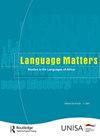对南非荷兰语和英语语言态度的肖像语料库研究
IF 0.8
3区 文学
0 LANGUAGE & LINGUISTICS
引用次数: 3
摘要
摘要语言画像是一种有用的工具,可以引起说话者对其语言的反思。在本研究中,我们实施了“肖像语料库方法”(Peters and Coetzee-Van Rooy 2020)来调查105幅语言肖像中南非荷兰语和英语的概念化。在这种方法中,我们使用参与者关于他们在人体轮廓上放置两种语言的反思作为语言语料库。依靠定量和定性分析使用WordSmith, Statistica和Atlas。然而,我们的研究表明,南非荷兰语主要被概念化为一种位于身体更外围区域的语言(例如,手和脚),因此,在参与者的技能中被认为不太重要。英语在大脑中的中心位置揭示了它在参与者的多语言库中作为重要语言的地位。我们认为,这些对南非荷兰语和英语的概念化提供了对南非人对这些语言的态度的额外见解。本文章由计算机程序翻译,如有差异,请以英文原文为准。
A Portrait-Corpus Study of Language Attitudes towards Afrikaans and English
Abstract Language portraits are useful instruments to elicit speakers’ reflections on the languages in their repertoires. In this study, we implement a “portrait-corpus approach” (Peters and Coetzee-Van Rooy 2020) to investigate the conceptualisations of the languages Afrikaans and English in 105 language portraits. In this approach, we use participants’ reflections about their placement of the two languages on a human silhouette as a linguistic corpus. Relying on quantitative and qualitative analyses using WordSmith, Statistica and Atlas.ti, our study shows that Afrikaans is mainly conceptualised as a language that is located in more peripheral areas of the body (for example, the hands and feet) and, hence, is perceived as less important in participants’ repertoires. The central location of English in the head reveals its status as an important language in the participants’ multilingual repertoires. We argue that these conceptualisations of Afrikaans and English provide additional insight into the attitudes towards these languages in South Africa.
求助全文
通过发布文献求助,成功后即可免费获取论文全文。
去求助
来源期刊

Language Matters
Multiple-
CiteScore
1.20
自引率
0.00%
发文量
19
期刊介绍:
The purpose of Language Matters is to provide a journal of international standing with a unique African flavour focusing on multilingualism in Africa. Although the journal contributes to the language debate on all African languages, sub-Saharan Africa and issues related to multilingualism in the southern African context are the journal’s specific domains. The journal seeks to promote the dissemination of ideas, points of view, teaching strategies and research on different aspects of African languages, providing a forum for discussion on the whole spectrum of language usage and debate in Africa. The journal endorses a multidisciplinary approach to the study of language and welcomes contributions not only from sociolinguists, psycholinguists and the like, but also from educationalists, language practitioners, computer analysts, engineers or scholars with a genuine interest in and contribution to the study of language. All contributions are critically reviewed by at least two referees. Although the general focus remains on multilingualism and related issues, one of the three issues of Language Matters published each year is a special thematic edition on Language Politics in Africa. These special issues embrace a wide spectrum of language matters of current relevance in Southern Africa.
 求助内容:
求助内容: 应助结果提醒方式:
应助结果提醒方式:


